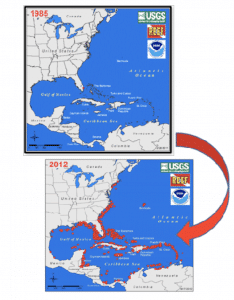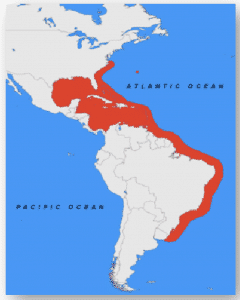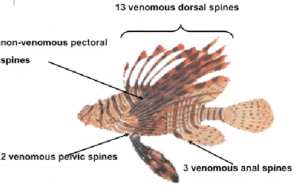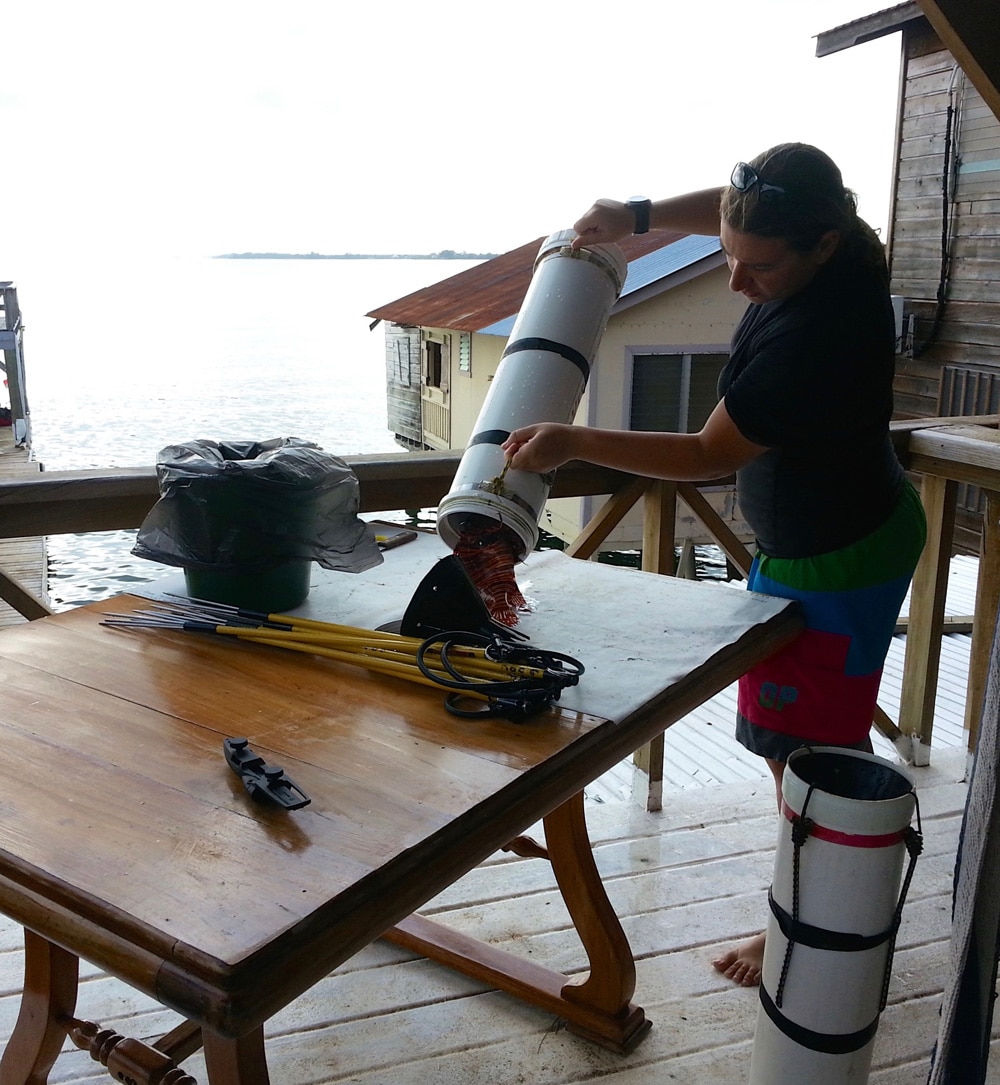Marine Life & Conservation Blogs
Lionfish: a very spiny problem!

For anyone who has been diving in the Caribbean in the last few years, you have probably heard of the lionfish problem. Having taught marine biology & conservation in the Caribbean for several years, it’s a question I get asked about a lot. This blog explains some of the facts about lionfish and what we can do to help our reefs:
- Where should they be?
- How did they get into the Caribbean?
- What is all the fuss about?
- What you can do to help the reefs?

Where should they be?
Lionfish are a beautiful predatory fish, native to the Indian and Pacific Oceans and the Red Sea.
In their native habitat the lionfish is great to observe and photograph. They are not very common as they have natural predators that keep population down and in balance with the other reef fish (Density/hectare in the Pacific is ~20).
How did they get into the Caribbean?
Unfortunately since 1992, two species of lionfish (Pterois volitans & Pterois miles) are now found in the Atlantic Ocean and the Caribbean Sea, where they are an invasive species. The theory is that captive lionfish were released or escaped off the coast of Florida and the population has spread. Lionfish established themselves in the Caribbean in less than 3 years and range from North Carolina to South America including the Gulf of Mexico. From a few individuals in 1992 the population has now spread out of control to become a major problem in the ecosystem (Density/hectare in Caribbean ~398 in 2012).


What is all the fuss about?
Why are lionfish an issue?
To understand the issue, we first need to know a bit about the fish.
Lionfish biology:

They have venomous tissue within their spines for protection and are generalist carnivores. Adults can grow up to 42cm and have a lifespan of 5-10 years. They become sexually mature in less than a year and spawn in pairs. Females can release 30,000 eggs at one time. Enclosed in a mucus layer, the eggs float to the surface. In a few days the mucus dissipates and the eggs are released to be dispersed by ocean currents.
Habitat & ecology
Lionfish inhabit all marine habitat types (reefs, lagoons, mangroves, sea grass beds, sand patches and artificial substrates) and can handle tropical temperatures all the way down to 10°C. They can also live at a huge range of depths (from shoreline to over 300m or 1000 feet), though they tend to be territorial, so may remain in the same area for up to 7 months. They appear to be attracted to cleaning stations.
So why are they a problem?
Lionfish have no natural predators in the Caribbean. The density per hectare of invasive lionfish is around 20x higher than in their native waters. They consume over 70 species of fish and many invertebrate species and can eat prey up to half their body length (basically they can eat pretty much anything!). This makes them top predators along with sharks, rays and groupers. By colonising mangroves and sea grass beds they pose a major threat to juvenile fish (this is where lots of baby fish live until they are big enough to survive out on the reef).
On heavily invaded sites, lionfish have reduced their fish prey population by up to 90% and continue to consume native fishes at unsustainable rates. Many reefs have been decimated of the native reef fish as the lionfish consume until supply of fish has run out. Once the food has run out, lionfish can survive for 12 weeks with no food, so can move on to other feeding grounds. Reefs without fish don’t function, so the coral also starts to suffer.
Invasive lionfish reproduction occurs throughout the year and as frequently as every 4 days (whereas native Indo-Pacific lionfish breed only once a year!). This means an invasive female lionfish can lay over 2 million eggs/year in the Caribbean. And unlike in the Indo-Pacific, many of these eggs will survive to adulthood. This means the populations are increasing at a phenomenal rate (700% in 4 years!).
Where lionfish containment programs operate, the deep dwelling fish can be very hard to get to in order to kill or capture. So lionfish pose a threat to the integrity of the reef food web and can have wide reaching impacts on commercial fisheries, tourism, and overall coral reef health.
What you can do to help the reefs?
Educate others and spread awareness of lionfish.
EAT THEM!! They are a delicious delicacy (see RECIPES below!). Also eating this fish reduces pressure on fish stocks of native species.

Encourage local restaurants to serve Lionfish and promote consumption by community members.
We need to be the main predator and keep dive sites as free of Lionfish as possible. Though we cannot get all of them, reducing the numbers on the coral reef and shallow water can really help native fish species and coral health.
Lionfish removal:
Spearing lionfish is quick and safe if done properly (Hawaiian Slings can be used very effectively). A tube container is recommended to store captured fish.

Many marine park authorities and islands have licensed spearing lionfish as local removal efforts can significantly reduce lionfish densities and subsequent impacts. Efforts are invaluable for supporting other conservation initiatives like management of marine protected areas, pollution control and fish stock rebuilding in order to help our reefs.
Try our favourite Lionfish Recipes! To see them click here.
- Island Lionfish Fry
- Lionfish Ceviche
- Lionfish Coconut Curry
- Coconut Lionfish with Spicy Mango Dip
- Marinara Lionfish Spaghetti
- Lionfish Tacos with Street Corn and Salsa
- Cajun Spiced Lionfish Fillets with Mango Salsa
- White Wine Lionfish
- Lionfish Sanganaki
- BBQ Lionfish: Kebabs and Parcels
Marine Life & Conservation Blogs
Creature Feature: Dusky Shark

 In this series, the Shark Trust will be sharing amazing facts about different species of sharks and what you can do to help protect them.
In this series, the Shark Trust will be sharing amazing facts about different species of sharks and what you can do to help protect them.
This month we’re taking a look at the Dusky Shark, a highly migratory species with a particularly slow growth rate and late age at maturity.
Dusky sharks are one of the largest species within the Carcharhinus genus, generally measuring 3 metres total length but able to reach up to 4.2 metres. They are grey to grey-brown on their dorsal side and their fins usually have dusky margins, with the darkest tips on the caudal fin.
Dusky Sharks can often be confused with other species of the Carcharhinus genus, particularly the Galapagos Shark (Carcharhinus galapagensis). They have very similar external morphology, so it can be easier to ID to species level by taking location into account as the two species occupy very different ecological niches – Galapagos Sharks prefer offshore seamounts and islets, whilst duskies prefer continental margins.
Hybridisation:
A 2019 study found that Dusky Sharks are hybridising with Galapagos Sharks on the Eastern Tropical Pacific (Pazmiño et al., 2019). Hybridisation is when an animal breeds with an individual of another species to produce offspring (a hybrid). Hybrids are often infertile, but this study found that the hybrids were able to produce second generation hybrids!
Long distance swimmers:
Dusky sharks are highly mobile species, undertaking long migrations to stay in warm waters throughout the winter. In the Northern Hemisphere, they head towards the poles in the summer and return southwards towards the equator in winter. The longest distance recorded was 2000 nautical miles!
Very slow to mature and reproduce:
The Dusky Shark are both targeted and caught as bycatch globally. We already know that elasmobranchs are inherently slow reproducers which means that they are heavily impacted by overfishing; it takes them so long to recover that they cannot keep up with the rate at which they are being fished. Dusky Sharks are particularly slow to reproduce – females are only ready to start breeding at roughly 20 years old, their gestation periods can last up to 22 months, and they only give birth every two to three years. This makes duskies one of the most vulnerable of all shark species.
The Dusky Shark is now listed on Appendix II of the Convention on the Conservation of Migratory Species (CMS), but further action is required to protect this important species.
Scientific Name: Carcharhinus obscurus
Family: Carcharhinidae
Maximum Size: 420cm (Total Length)
Diet: Bony fishes, cephalopods, can also eat crustaceans, and small sharks, skates and rays
Distribution: Patchy distribution in tropical and warm temperate seas; Atlantic, Indo-Pacific and Mediterranean.
Habitat: Ranges from inshore waters out to the edge of the continental shelf.
Conservation status: Endangered.
For more great shark information and conservation visit the Shark Trust Website
Images: Andy Murch
Diana A. Pazmiño, Lynne van Herderden, Colin A. Simpfendorfer, Claudia Junge, Stephen C. Donnellan, E. Mauricio Hoyos-Padilla, Clinton A.J. Duffy, Charlie Huveneers, Bronwyn M. Gillanders, Paul A. Butcher, Gregory E. Maes. (2019). Introgressive hybridisation between two widespread sharks in the east Pacific region, Molecular Phylogenetics and Evolution 136(119-127), https://doi.org/10.1016/j.ympev.2019.04.013.
Marine Life & Conservation Blogs
Creature Feature: Undulate Ray

 In this series, the Shark Trust will be sharing amazing facts about different species of sharks and what you can do to help protect them.
In this series, the Shark Trust will be sharing amazing facts about different species of sharks and what you can do to help protect them.
This month we’re looking at the Undulate Ray. Easily identified by its beautiful, ornate pattern, the Undulate Ray gets its name from the undulating patterns of lines and spots on its dorsal side.
This skate is usually found on sandy or muddy sea floors, down to about 200 m deep, although it is more commonly found shallower. They can grow up to 90 cm total length. Depending on the size of the individual, their diet can range from shrimps to crabs.
Although sometimes called the Undulate Ray, this is actually a species of skate, meaning that, as all true skates do, they lay eggs. The eggs are contained in keratin eggcases – the same material that our hair and nails are made up of! These eggcases are also commonly called mermaid’s purses and can be found washed up on beaches all around the UK. If you find one, be sure to take a picture and upload your find to the Great Eggcase Hunt – the Shark Trust’s flagship citizen science project.
It is worth noting that on the south coasts, these eggcases can be confused with those of the Spotted Ray, especially as they look very similar and the ranges overlap, so we sometimes informally refer to them as ‘Spundulates’.
Scientific Name: Raja undulata
Family: Rajidae
Maximum Size: 90cm (total length)
Diet: shrimps and crabs
Distribution: found around the eastern Atlantic and in the Mediterranean Sea.
Habitat: shelf waters down to 200m deep.
Conservation Status : As a commercially exploited species, the Undulate Ray is a recovering species in some areas. The good thing is that they have some of the most comprehensive management measures of almost any elasmobranch species, with both minimum and maximum landing sizes as well as a closed season. Additionally, targeting is entirely prohibited in some areas. They are also often caught as bycatch in various fisheries – in some areas they can be landed whilst in others they must be discarded.
IUCN Red List Status: Endangered
For more great shark information and conservation visit the Shark Trust Website
Image Credits: Banner – Sheila Openshaw; Illustration – Marc Dando
-

 News3 months ago
News3 months agoHone your underwater photography skills with Alphamarine Photography at Red Sea Diving Safari in March
-

 News3 months ago
News3 months agoCapturing Critters in Lembeh Underwater Photography Workshop 2024: Event Roundup
-

 Marine Life & Conservation Blogs3 months ago
Marine Life & Conservation Blogs3 months agoCreature Feature: Swell Sharks
-

 Blogs2 months ago
Blogs2 months agoMurex Resorts: Passport to Paradise!
-

 Blogs2 months ago
Blogs2 months agoDiver Discovering Whale Skeletons Beneath Ice Judged World’s Best Underwater Photograph
-

 Gear Reviews2 weeks ago
Gear Reviews2 weeks agoGEAR REVIEW – Revolutionising Diving Comfort: The Sharkskin T2 Chillproof Suit
-

 Marine Life & Conservation2 months ago
Marine Life & Conservation2 months agoSave the Manatee Club launches brand new webcams at Silver Springs State Park, Florida
-

 Gear Reviews3 months ago
Gear Reviews3 months agoGear Review: Oceanic+ Dive Housing for iPhone






















